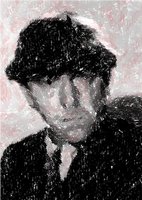Stooge #1

At the height of their film careers, the Three Stooges (Moe Howard, Larry Fine, and a third -- sometimes Moe's older brother Shemp, sometimes Moe's younger brother Curly, sometimes a Curly substitute) were space-fillers, poverty row grotesques who were barely acknowledged by Hollywood as their own. When their short films began to be shown on TV in the 1950s, they became mid-day children's favorites; and by the end of the 20th century, they went from being the guilty pleasures of adults who grew up during the 1950s to being lauded as pop culture icons of comic idiocy.
Moe Howard (born Moses Horwitz on this day in 1897 in Brooklyn, New York) began his professional life as a comedian with his childhood friend Ted Healy in vaudeville, at one point, in 1912, playing "diving girls" in swimmer Annette Kellerman's diving act. Later they developed their own act: while Healy performed on stage, Howard would heckle him from the audience. Eventually Fine and Shemp joined the act, and for the next several years, the mob of them played the top vaudeville circuits around the country as "Ted Healy and his Gang," "Ted Healy and his Southern Gentlemen," "Ted Healy and his Racketeers," and eventually, "Ted Healy and his Stooges."
In the early 1930s, Ted Healy was signed by MGM to appear in a few short films with the Stooges in support, but when Moe, Larry and Curly were invited to join Columbia Pictures (then considered close to the bottom of the barrel of Hollywood studios), Healy stayed with MGM and the "Three Stooges" were born. In 190 short films from 1934 to 1959, their formula stayed simple: put them in some highly unlikely context (as archaeologists, or in an artist's studio, or in a society mansion), give them a mission (often a get-rich-quick scheme), and watch their tiny brains turn their plan and everything around it into chaos.
Moe, the caustic, marginally more intelligent character, was usually the leader and the chief deliverer of the carefully-choreographed cartoon punishment for which the Stooges are famous, displaying a staggering variety of ways to slap, jab, poke and hit Larry and Curly (with appropriately inane sound effects); in the arc of Stooge engineering, however, Moe would usually get his own back. Looking like preposterous little human specimens to begin with (Moe's physique was marked by his trademark bowl haircut, his puggish mug and, in the words of Jack Kerouac, his "thunderstorm of eyebrows"), the violence never seemed real or particularly painful, and in the words of critic Nora Sayre, it was "a pleasure to see them bashing skulls and tweaking noses while falling about like small children unaccustomed to ice skates."
They appeared in a few feature films after their retirement from Columbia (such as Snow White and the Three Stooges, 1961), their timing so perfectly refined that it was scarcely noticed that they were 60-year olds -- but despite their iconic status, "refined" is the last superlative people generally think of when considering the Stooges, and to this day, Moe and the Stooges are still regarded by canon-compilers as crude interlopers in the history of cinematic comedy. Moe Howard died on May 4, 1975 in Los Angeles, California.
Labels: Classic Cinema





1 Comments:
A Stooge story: The year was 1990 (give or take a year). The place: a friend's living room in Ridgewood, NJ. The scene: a late-Sunday morning after a Saturday night party at said house; not so severely hungover; Moe, Larry and Curley on the tube. My then-fairly-new wife cozies up to me on the couch for some smooching...I say "not now, Honey...The Stooges." Johnny Taint still laughs at that one.
Post a Comment
Subscribe to Post Comments [Atom]
<< Home